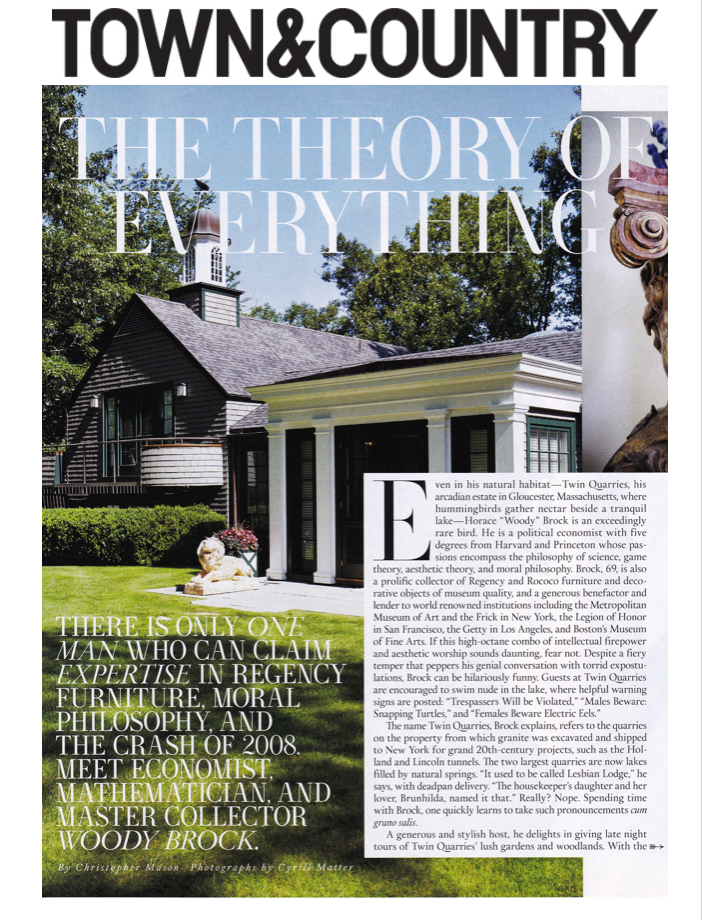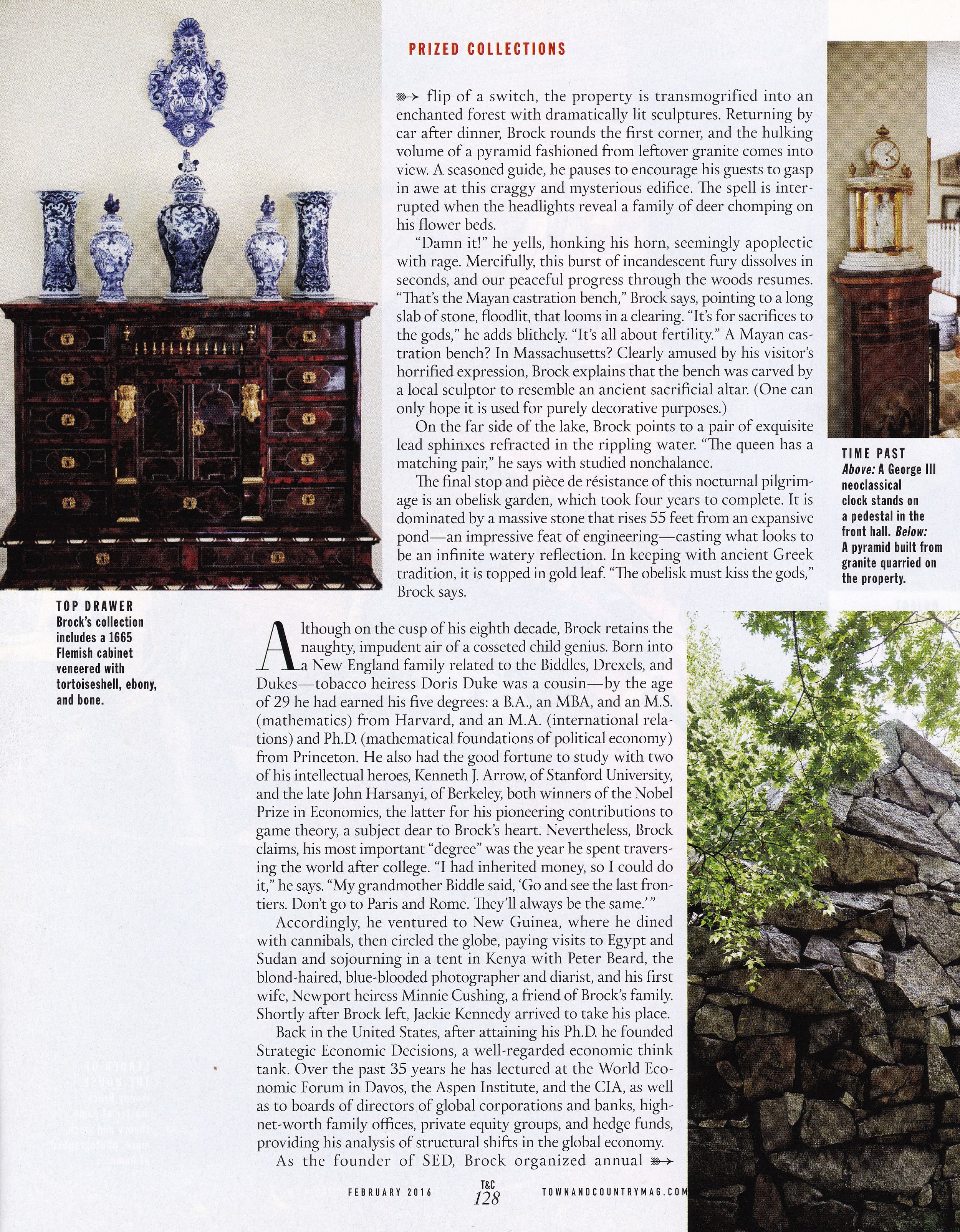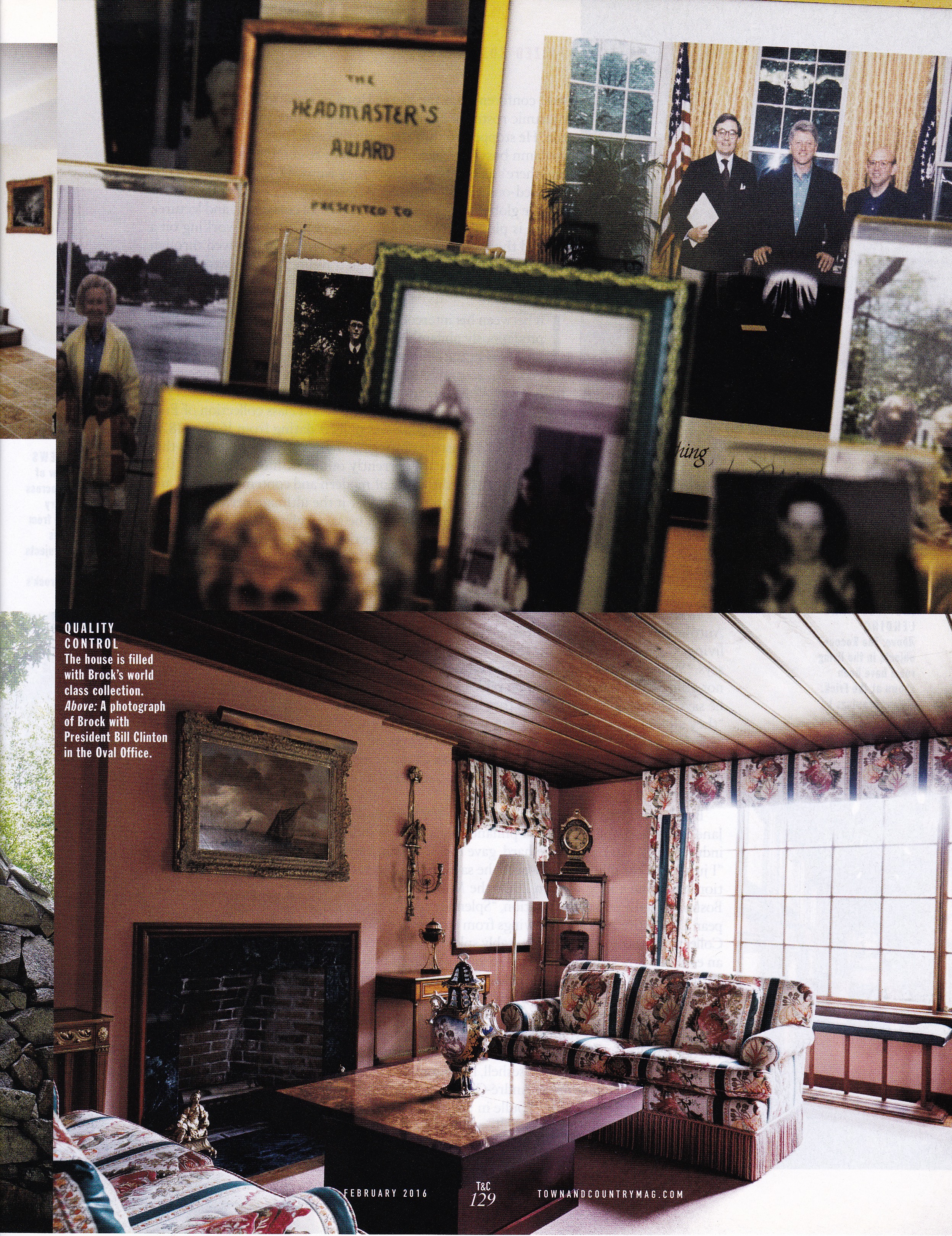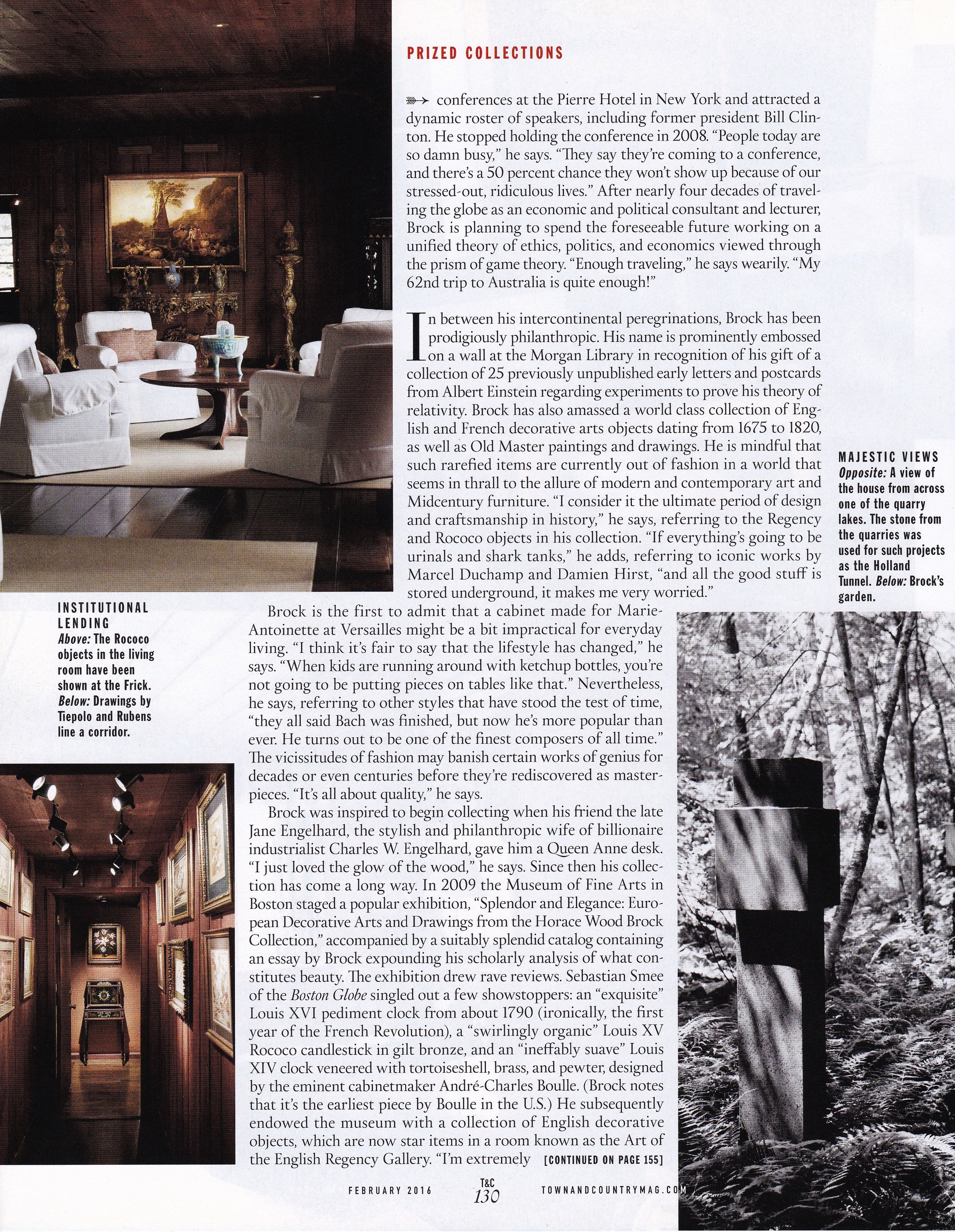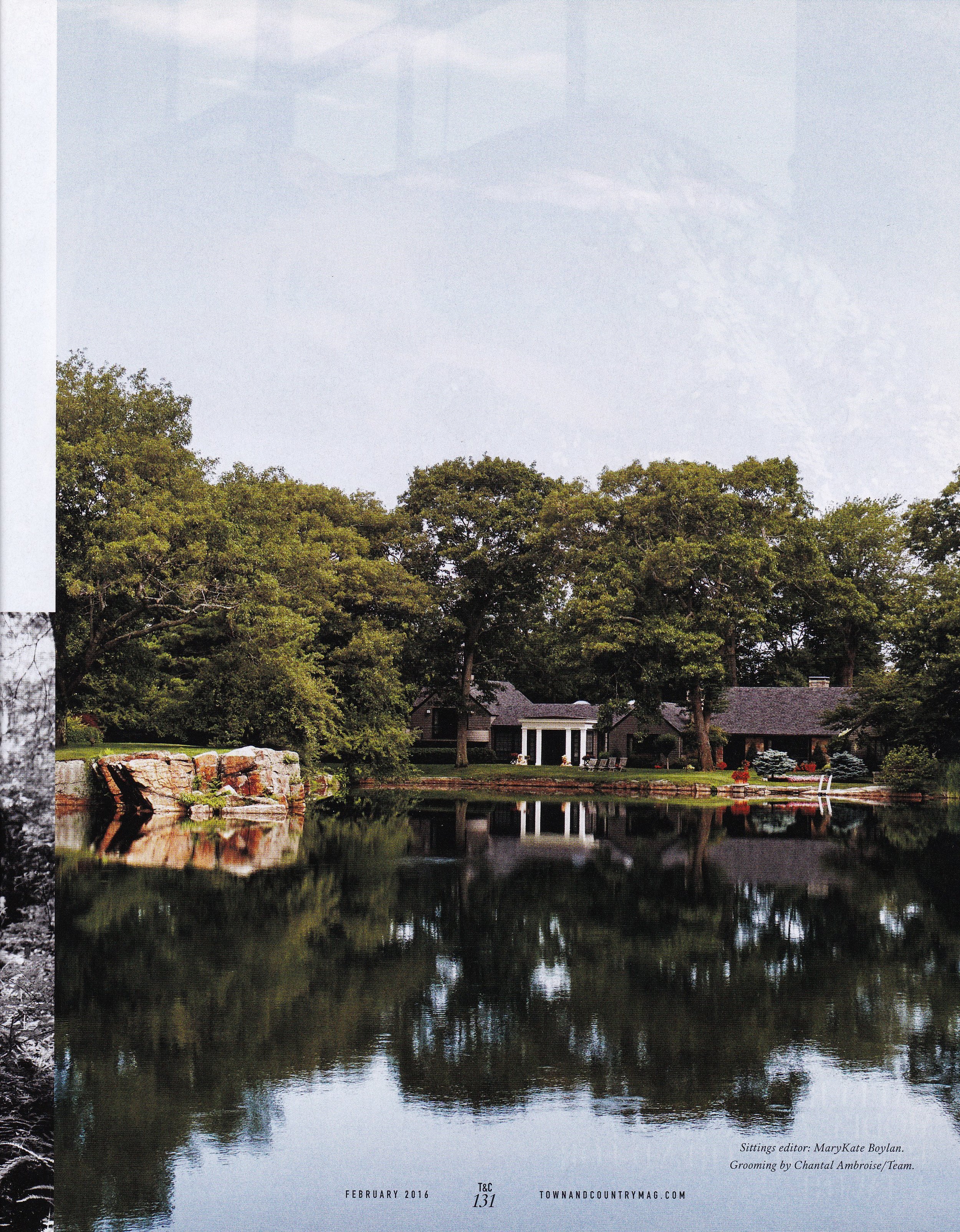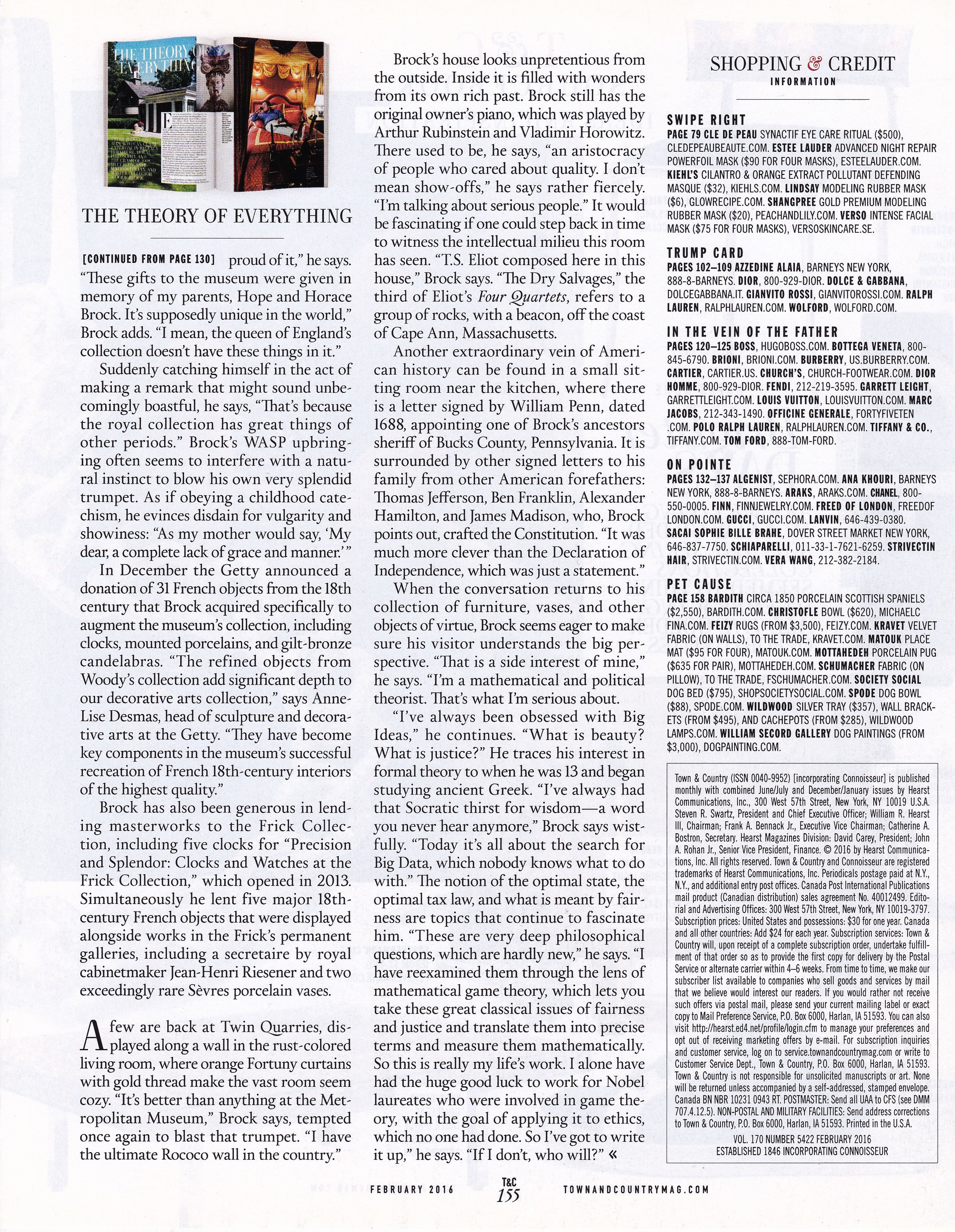Woody Brock: The Theory of Everything
By CHRISTOPHER MASON
Published in Town & Country magazine, February 2014
Even in his natural habitat “Twin Quarries”—his Arcadian estate in Gloucester, Mass., where hummingbirds gather nectar beside a tranquil quarry lake—Horace “Woody” Brock is an exceedingly rare bird.
A political economist with five degrees from Harvard and Princeton, his passions encompass the philosophy of science, game theory, aesthetic theory, and moral philosophy. Dr. Brock, 69, is also a prolific collector of Regency and Rococo furniture and decorative objects of museum quality, and a generous benefactor and lender to world-renowned institutions including the Frick Collection in New York, San Francisco’s Legion of Honor, the Getty in Los Angeles, and Boston’s Museum of Fine Arts.
If this high-octane combo of intellectual firepower and aesthetic worship sounds daunting, fear not. Despite a fiery temper that peppers his genial conversation with torrid expostulations, Brock can also be hilariously funny. Guests at Twin Quarries are encouraged to swim nude in the lake, where helpful warning signs are posted along the waterfront: “Trespassers will be violated,” “Males Beware: Snapping Turtles,” and “Females Beware electric eels.”
Oh my! Walden Pond was never like this.
The name of the estate, Twin Quarries, Brock explains, refers to 19th-century excavations for granite used to construct the Brooklyn Bridge and the Holland Tunnel in the 1880s. The quarries are now lakes filled by natural springs. “It used to be called Lesbian Lodge,” he says, with deadpan delivery. “The housekeeper’s daughter and her lover, Brunhilda named it that.”
Really? Nope. Spending time with Brock, one quickly learns to take such pronouncements cum grano salis.
A generous and stylish host, he delights in giving late-night tours of Twin Quarries’ lush gardens and woodland. With the flip of a switch, the property is transmogrified into an enchanted forest with dramatically lit sculpture.
Returning by car after dinner, Brock rounds the first corner to reveal the hulking volume of a pyramid fashioned from left-over granite. A seasoned guide, he pauses to encourage his guests to gasp in awe at this craggy and mysterious edifice.
The magical spell is interrupted when the headlights reveal a family of deer chomping on his flower beds.
“Dammit!” he yells, honking his horn, seemingly apoplectic with rage.
Mercifully, this burst of incandescent fury dissolves in seconds, and our peaceful progress through the woods resumes. “That’s the Mayan castration bench,” Brock says, pointing to a long, low slab of stone, floodlit, that looms amid a clearing in the woods. “It’s for sacrifices to the gods,” he adds, blithely, “It’s all about fertility.”
A Mayan castration bench? In Massachusetts?
Clearly amused by his visitor’s horrified expression, Brock explains that the bench was carved by a local sculptor to resemble an ancient sacrificial altar. (One can only hope it is used for purely decorative purposes.)
On the far side of the lake, Brock points to a pair of exquisite marble sphinxes, refracted in the rippling water.“The Queen has the other pair,” Brock says, with studied nonchalance.
The final stop and pièce de resistance of this nocturnal pilgrimage is the Obelisk Garden, which took four years to complete. It is dominated by a massive stone obelisk that rises skyward thirty feet from an expansive pond—an impressive feat of engineering—casting a seemingly infinite watery reflection. In keeping with ancient Greek tradition, it is topped with gold leaf.
“The obelisk must kiss the gods,” Brock says.
Having enjoyed a few cocktails, he wanders into his living room, sits at the piano and plays a Bach toccata, followed by the Adagio movement of Beethoven’s Pathètique piano sonata.
He then ambles off, announcing: “Now I’m going to go and solve an equation.”
Not your average Town & Country interview, this visitor reflects.
Woody Brock's living room at Twin Quarries
Although on the cusp of his seventh decade, Brock retains the naughty, impudent air of a cosseted child genius. Born into a wealthy WASP New England family related to the Biddles, Drexels, and Dukes—tobacco heiress Doris Duke was a cousin—he earned his five degrees by the age of 29: a B.A., an M.B.A., and an M.S. (mathematics) from Harvard, and an M.A. (International Relations) and Ph.D. (mathematical foundations of political economy) from Princeton.
He also had the good fortune to study with two of his intellectual heroes, Kenneth J. Arrow of Stanford University and the late John C. Harsanyi of Berkeley, both winners of the Nobel Prize in Economics for their invention of Game Theory, a subject dear to Brock’s heart.
Nevertheless, he claims, his most important “degree” was the year he spent traversing the world after college. “I had inherited money, so I could do it,” Brock says. “My grandmother Biddle said, ‘Go and see the last frontiers. Don’t go to Paris and Rome. They’ll always be the same.’ ”
Accordingly, he ventured to New Guinea, where he dined with cannibals, then encircled the globe, paying visits to Egypt and the Sudan, and sojourning in a tent in Kenya with Peter Beard, the blond-haired, blue-blooded photographer and diarist, and his first wife, Newport heiress Minnie Cushing, a friend of Brock’s family. Shortly after he left Jacqueline Kennedy arrived to take his place.
Back in the United States, after attaining his Ph.D., he founded Strategic Economic Decisions, a well-regarded economic think tank. Over the past 35 years, he has lectured at the World Economic Forum in Davos, the Aspen Institute, the CIA, and to boards of directors of global corporations and banks, high net-worth family offices, private equity groups, and hedge funds, providing his analysis of structural shifts in the global economy.
“I speak all over the world because I’m invited to,” Brock says.
As the founder of S.E.D., he organized annual conferences at the Pierre Hotel and attracted a dynamic roster of speakers, including former President Bill Clinton. Brock’s witty, pithy, and often outrageous remarks were hallmarks of his conferences and are still remembered by attendees years later, even though he decided to stop holding them in TKYEAR.
“People today are so damned busy,” he says, “They say they’re coming to conference and there’s a 50 percent chance they won’t show up because of our stressed-out, ridiculous life.”
One year, an attendee recalls, “In his opening remarks Woody said, ‘We’re here today to figure out how we can avoid spending our retirement in an Airstream trailer on a diet of cat food soufflé.’”
Brock chuckles when reminded of those bon mots. “I added, ‘The only way I avoid that fate is to write down how the rest of you will live that fate,” he recalls. “‘I make money by spilling the beans!’”
Apparently delighted to be reminded that many of his trenchant observations are highly quotable, Brock closer leans to whisper into the ear of this astonished visitor, as if imparting a guilty secret in the confession box:
“You know, I say these outrageous things all over the world,” he says, grinning. “I say them with a totally straight face. You have to look very serious. Never smile.”
Incorrigibly impish, he describes a typical scenario: “You can go into a restaurant and say you’ve just seen a commentary in the New York Times that Hillary Clinton is openly discussing the possibility of a sex change,” he says.
On such occasions he waits, often in vain, for a scandalized reaction. Brock’s wilder assertions used to elicit shrieks, but in this brave new world in which Caitlyn Jenner is a coveted cover girl, he observes, “Nothing seems impossible today. People are so used to being shocked, they aren’t shocked anymore.”
After nearly four decades of traversing the globe as an economic and political consultant and lecturer, Brock is planning to retire this year (2016) to spend the foreseeable future working on a unified theory of ethics, politics, economics and aesthetics through the prism of Game Theory.
“Enough traveling and lecturing,” he says, wearily. “My 62nd trip to Australia is quite enough!”
Meanwhile, in between his transcontinental peregrinations, Brock has been prodigiously philanthropic. His name is prominently inscribed on a wall at the Morgan Library in recognition of his gift to the Library of an important collection of 25 previously unpublished early letters and postcards from Albert Einstein regarding experiments to prove his Theory of Relativity.
The good doctor Brock has alsocreated a world-class collection of English and French decorative arts dating from 1675 to 1820, as well as Old Master paintings and drawings. He is mindful that such rarefied objects are currently out of fashion in a world that seems in thrall to the allure of Modern and Contemporary art and midcentury furniture.
TOP DRAWER: Woody Brock's collection
“I consider it the ultimate period of design and craftsmanship in history,” he says, referring to the Regency and Rococo objects in his collection.
“If everything’s going to be urinals and shark tanks,” he adds, referring to iconic works by Marcel Duchamp and Damien Hirst, “and all the good stuff is stored underground, it makes me very worried.”
He is the first to admit that a Boulle cabinet made for Marie-Antoinette at Versailles might be a bit impractical for everyday modern living. “I think it’s fair to say that the lifestyle has changed so much,” Brock says. “When kids are running around with ketchup bottles you’re not going to be putting them on tables like that.”
Nevertheless, he says, referring to other masterpieces that have stood the test of time, “They all said that Bach was finished. But now he’s more popular than ever. He turns out to be one of the finest composers of all time.”
The vicissitudes of fashion may banish certain works of genius for decades or even centuries before they are rediscovered as masterpieces.
“It’s all about quality,” he says.
Brock was inspired to begin collecting, he recalls, when his friend the late Jane Engelhard, the stylish and philanthropic wife of billionaire industrialist Charles W. Engelhard, gave him a Queen Anne desk.
“I just loved the glow of the wood,” he recalls.
Since then, his collection has come a long way. In 2009, the Museum of Fine Arts in Boston staged a popular exhibition, “Splendor and Elegance: European Decorative Arts and Drawings from the Horace Wood Brock Collection,” accompanied by a suitably splendid catalogue containing an essay by Brock expounding his scholarly analysis of what constitutes beauty.
The exhibition drew rave reviews. Sebastian Smee of The Boston Globe singled out a few showstoppers: an “exquisite” Louis XVI Neoclassical pediment clock from about 1790, ironically the first year of the French Revolution; a “swirlingly organic” Louis XV Rococo candlestick in gilt bronze; and an “ineffably suave” Louis XIV clock veneered with tortoiseshell, brass, and pewter, designed by the eminent French cabinetmaker André-Charles Boulle, which Brock notes is the earliest piece by Boulle in the US.”
Brock subsequently endowed the Museum with a collection of objects that are now star items in a room known as The English Regency gallery at Boston’s Museum of Fine Arts.
“I’m extremely proud of it,” he says. “These gifts to the museum were given in memory of his parents, Hope and Horace Brock. It’s supposedly unique in the world,” Brock adds. “I mean, the Queen of England’s collection doesn’t have these things in it.”
Suddenly catching himself in the act of making a remark that might sound unbecomingly braggadocious, he adds: “That’s because the royal collection has great things of otherperiods.”
Brock’s WASP upbringing often seems to interfere with a natural instinct to blow his own very splendid trumpet. As if obeying a childhood catechism he evinces disdain for vulgarity and showiness:
“As my mother would say, ‘My dear, a complete lack of grace and manner.’”
In December,[2015] the Getty Museum in Los Angeles announced a major combined acquisition and donation of 31 eighteenth-century French objects that Brock acquired specifically to augment the Getty’s collection, including clocks, mounted porcelains, and gilt-bronze candelabras, firedogs and vases, and a gilt-wood console table.
“The very high quality and refined objects from Woody’s collection add significant depth to the Gerry’s decorative arts collection,” says Anne-Lise Desmas, the head of decorative arts and sculpture at the Getty. “They have become key components in the Museum’s successful recreation of French eighteenth-century interiors of the highest quality.”
Brock has also been generous loaning masterworks from his collection to the Frick Collection, including five magnificent clocks to the exhibition “Precision and Splendor: Clocks and Watches at the Frick Collection,” which opened in 2013. [which remained on display at the Frick for [four] years after the exhibition.] Simultaneously, Brock]] He has also lent nine [four] major [pieces of] French 18th-century objects from his collection that were displayed alongside works [, with not mention of the lender,] in the Frick’s permanent galleries, including a sécretaire by Royal cabinetmaker Jean-Henri Riesener, and two exceedingly rare Sèvres porcelain vases.
They are now back at Twin Quarries, displayed along one wall in the rust-colored living room, where orange Fortuny curtains with golden thread make a vast room seem cozy.
“It’s better than anything at the Metropolitan Museum of Art,” he says, tempted once again to blast that trumpet. “I have the ultimate Rococo wall in the country,” he adds, modestly.
Brock’s house looks cozy and unpretentious from the exterior. Inside it is filled with rare wonders and talismans of a rich and glorious cultured past. Brock still has the original owner’s piano, which was played by Arthur Rubenstein and Vladimir Horowitz. “It was a very civilized life back then,” Brock says. “There was an aristocracy of people who cared about quality. I don’t mean showoffs,” he adds, rather fiercely. “I’m talking about serious people.”
It would be fascinating if one could step back in time to witness the rich intellectual milieu that this room has witnessed.
“T.S. Eliot wrote [[the Fourth Quartet]]here in this house,” Brock says.
[“Dry Salvages,” the third of T.S. Eliot’s Four Quartets, refers to a group of rocks, with a beacon, off the coast of Cape Ann, Massachussetts.]
Another extraordinary vein of American history can be found in a small red-and-green sitting room off the kitchen, where he points to a letter signed by William Penn, dated 1688, appointing one of his ancestors sheriff of Bucks County, Pennsylvania. It is surrounded by other signed letters to his family from other American forefathers: Thomas Jefferson, Ben Franklin, Alexander Hamilton, and James Madison, who, Brock points out, crafted the constitution. “It was much more clever than the Declaration of Independence, which was just a statement,” Brock says, rather witheringly.
“These are people who were in the crosshairs of history,” he marvels.
When the conversation returns to his spectacular collection of furniture, vases, and other objects of virtue, Brock seems eager to make sure his visitor understands the big perspective.
“That is a side interest of mine,” he says, referring to his collections. “I’m a mathematical and political theorist. That’s what I’m serious about.”
“I’ve always been obsessed with Big Ideas,” he continues. “What is beauty? What is justice?” He traces his fascination for formal theory to the age of 13, when he began studying ancient Greek. “I’ve always had that Socratic thirst for wisdom—a word you never hear anymore,” Brock says, wistfully. “Today it’s all about the search for Big Data, which nobody knows what to do with.”
The notions of the optimal state, the optimal tax law, and what is meant by fairness, are topics that continue to fascinate him. “These are very deep philosophical questions, which are hardly new,” he says. “I have reexamined them through the lens of mathematical Game Theory.”
“With Game Theory,” he continues, “you can take these great classical issues of fairness and justice and translate them into precise terms and measure them mathematically. So this is really my life’s work. I consider my career and my collecting to be a sideshow.”
“So to me Game Theory is the tool,” he says. “Over 40 years I’ve been using it to try and unearth these concepts. I alone have had the huge good luck to work for Nobel Laureates who were involved in Game Theory, with the goal of applying it to ethics, which no one had done.”
“So I’ve got to write it up,” he says. “If I don’t, who will?






